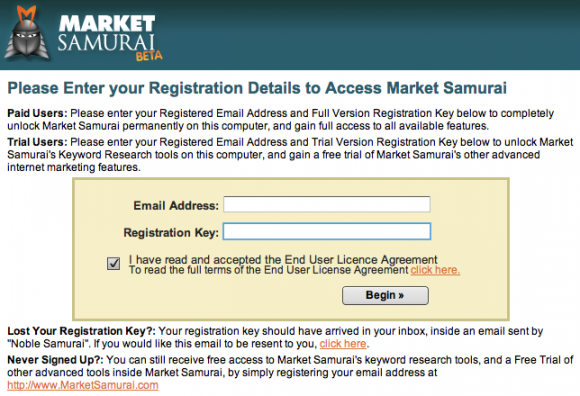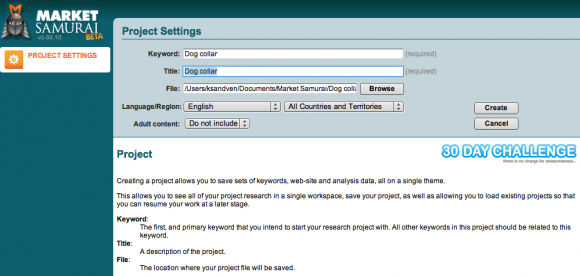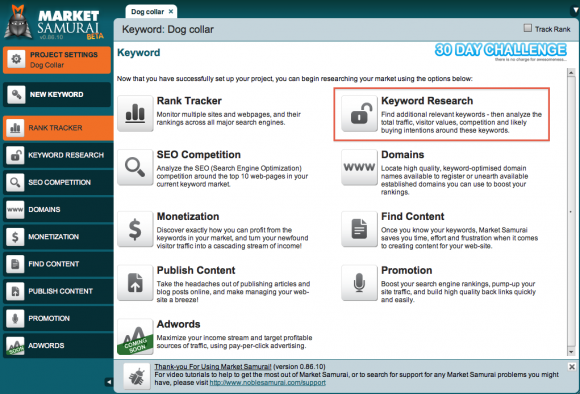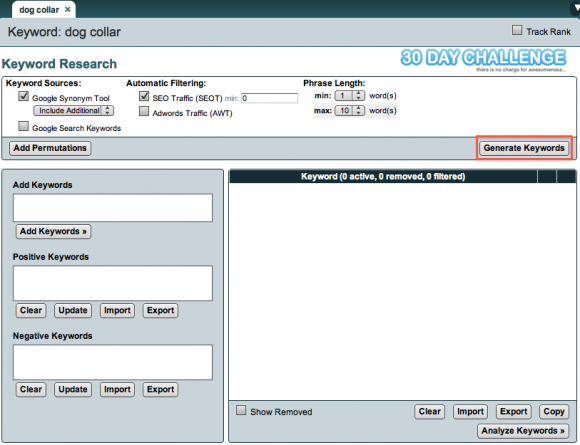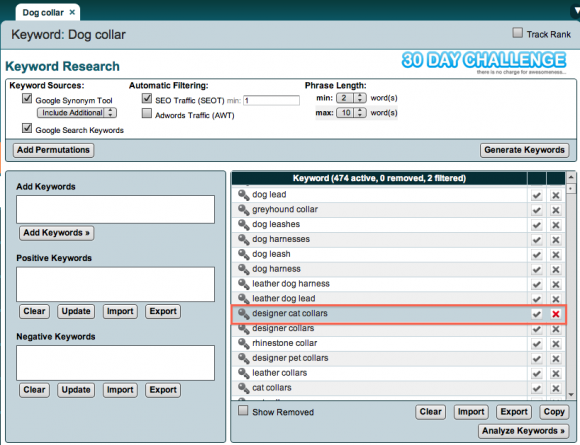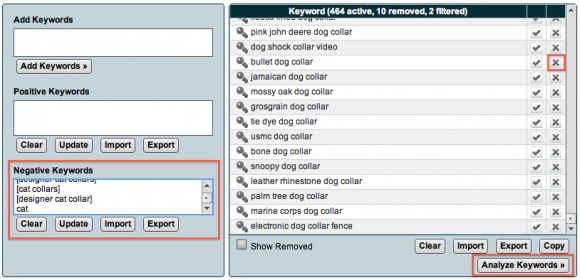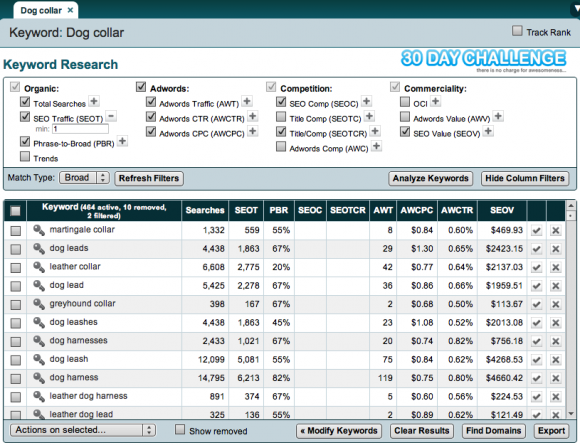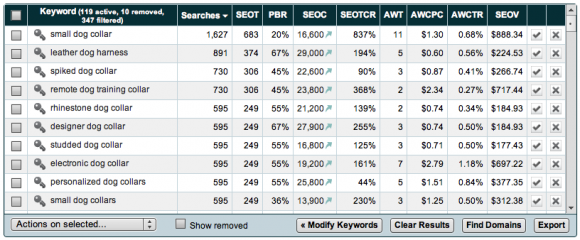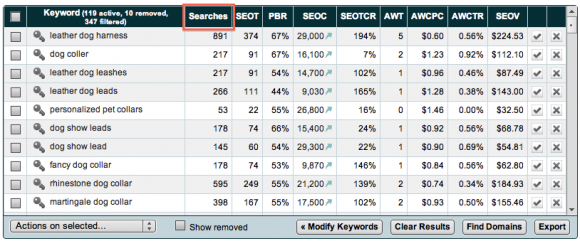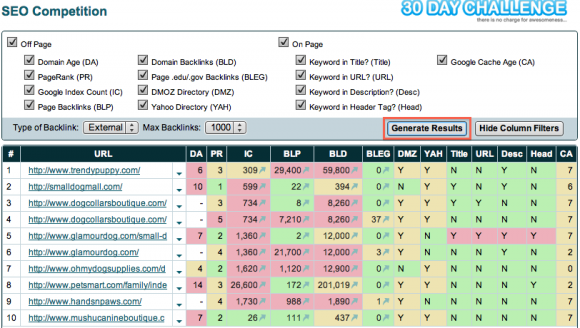 If you have a Joomla website, you probably want it to be visible in the search engines. And particularly in Google.
If you have a Joomla website, you probably want it to be visible in the search engines. And particularly in Google.
There are many things you can do to get your Joomla site indexed in Google. But how do you make sure that your site is visible on the right keywords and phrases? What I mean is: How do you know that the words you use are the ones that people use when they search for your products or services?
To be successful with Search Engine Optimization (SEO), you need to optimize for the correct words and phrases.
But how do you know what people search for when looking for your products or service? You need to do some research: Keyword research.
The tool I use for keyword research is Market Samurai. It's a great piece of software and available as a free download to try it out.
Market Samurai features
Market Samurai is a software package running on the Adobe Air platform. This means you can run the software on Windows, Mac OS X or other platforms and the software itself is the same. It's also very easy to upgrade to new versions through the Adobe Air updater.
The product consists of a toolbox of modules that you can use to improve the search engine rankings of your website. You can also use iit to help monetize your site or to improve the content.
The free version of this software gives you a keyword research module. The paid version also provides the following module:
- SEO Competition – Analyze your 10 top-ranked competitors, or your own site.
- Rank Tracker – track all of your search engine rankings.
- Domains – Locate high quality, keyword-optimised domain names available to register or unearth available established domains you can use to boost your rankings.
- Monetization – Find products and services to promote, and earn money.
- Find Content – Research articles that are relevant to your keyword.
- Publish Content – Publish content to the web- on your own site and beyond.
- Promotion – Find high quality back link opportunities.
- Adwords – Use Pay-Per-Click advertising strategies to attract site visitors. *Coming Soon*.
I bought the full package about two years ago, and I'm really happy with the product. I think the research I did by using Market Samurai is one of the main reasons Joomlablogger.net ranks so well in search engines today.
How to use Market Samurai for Keyword Research
Now, back to our keyword research.
Let's say you sell dog collars. How do you know what people search for when looking for this kind of products? If this is your business, you might have some niche specific knowledge. You might know what works from looking at your website statistics etc. That will help you. But now you need to do some keyword research to really know what people are looking for.
It's no use optimizing your page for dog leashes if your audience searches for dog collars. Also, you can determine if it's any use optimizing for 'dog collar' at all, or if the competition is too high in the market. You might want to go for a longer phrase with a decent amount of traffic and a lower competition.
Keyword research is important! You need it to:
- Know which keywords and phrases that will make you money
- Focus your online marketing (Google Adwords etc)
- Know what content to produce for your website and what keywords to use in that content
- How to structure and name your menu items and URLs
I will not go deeply into the concept of keyword research in this post. However, I will give you some idea about what this is all about, and help you get started using this particular software to conduct keyword research.
So let's get started doing some keyword research:
First, you need to sign up and download the package. Install the package. It will also install Adobe Air if you don't have that already. When you've signed up, you will get a license code that you can enter into the software:
Now you're ready to start. You will see this screen:
Click 'New project'. Your projects can be found in the main screen under 'Open a recent projects'.
You will get this screen:
Now let's start a new project,
Enter the main keyword or phrase for your research into this screen. You can also tell the software what languages an geographical areas to include. Or to include adult content or not. Click 'Create' to start your project.
Market Samurai will show you the following main screen:
The keyword you entered has it's own tab at the top of the screen. You can add more main keywords to the research and they will each get their own tab.
Notice that this is the paid version. In your free version, some of the buttons on the left will be grayed out.
Now you can start working with the keyword research module.
What you want to do now is to find a list of related words and phrases for 'dog collar'. I normally check the box 'Google Search Keywords' before I click 'Generate Keywords' to fetch the list of keywords. You can leave the rest of the settings for now.
You will be asked to enter a CAPTCHA code:
Market Samurai then fetches the search engine data:
When the fetch is done, you're presented with a list of keywords that Google found for your main keyword (dog collar).
You can see that there are some keywords that clearly don't match our product range. If you don't have cat collars, those keywords should be removed. You can do that in two ways:
- By clicking the X to the right of each keyword you want to remove
- By entering negative keywords in the 'Negative keywords' field. This last action will remove all instances of anything containing the negative keyword.
You can click the X behind 'designer cat collars' and it will disappear from the list. It will reappear in the 'Negative keywords' field.
You can also enter 'cat' into the 'Negative keywords' field to remove all phrases containing the word cat:
As you now have a list of relevant keywords, you're ready to analyze your keywords.
Click the 'Analyze Keywords' button in the lower right hand corner.
You will see the 'Analyze keywords' screen:
As you can see, there is a lot of information here already. We can get information about each keywords on:
- Total Searches – Average number of people who search for this keyword daily.
- SEO Traffic (SEOT) – The maximum potential daily clicks that a #1 ranked site for this keyword term could potentially achieve.
- Phrase-to-Board (PBR) – The percentage of phrase-match searches out of broad-match searches for this keyword.
- Trends – Indicates monthly traffic trends for a particular keyword.
- Adwords Traffic (AWT) – the total daily traffic (clicks) that a #1 ranked Google Advertiser for a keyword might expect to receive from their ads.
- Adwords CTR (AWCTR) – The percentage of people who click on the #1 ranked advertiser in Google (AWT) as a percentage of total traffic for a keyword.
- Adwords CPC (AWCPC) – An indication of what you might expect to pay to be the #1 ranked advertiser for a particular keyword in Google.
- SEO Comp (SEOC) – The total number of web pages globally that mention a specific keyword term, in the same (phrase) word order, in Google's index.
- Title Comp (SEOTC) – the total number of web pages globally that mention all of the words in a keyword term in the title of the page.
- Title/Comp (SEOTCR) – this is the ratio of SEOTC to SEOC. A low score can indicate weak competition in a market.
- Adwords Comp (AWC) – represents the number of advertisers bidding on a keyword (worldwide), and how this compares to other keywords.
- OCI – An indicator of the chances that someone searching for a keyword is looking to buy as opposed to browsing for information.
- Adwords Value (AWV) – The total daily value of traffic (and also the costs) a #1 ranked Google Adwords advertiser might expect to receive if advertising for a keyword. (AWV= AWT x AWCPC)
- SEO Value (SEOV) – The total value of traffic that a web-site that ranked #1 for a keyword in Google. It's value is an indicator of the value of a keyword market. (SEOV = SEOT x AWCPC)
To start with, we don't need all of this information. I usually start with settings like the ones below:
So I set SEO traffic to at least one search per day, the 'phrase-to-broad' to minimum 15, the SEO competition to not more than 30000 pages, and the SEO value to at least $1.
This way, I will filter out the keywords that are among the easiest to optimize for, and that I have a fair chance of competing for.
Then, click 'Analyze Keywords'.
The software will now fetch the information for different sources:
Market Samurai presents the results, and you're ready to analyze them:
You might want to sort the list in different ways to understand the data better. If you change the values above the list, the list updates instantly. This way, you can play with the settings, like the SEO competition value, to see how it affects the keyword selection. For instance, try changing the SEOC value to 100,000 and see what happens.
Using the Rank Tracker
Even though the Rank Tracker is not part of the free version, I would like to show it to you. When you're in the 'Keyword Research' module, in the Paid version you have the option of adding the keywords to the Rank Tracker directly.
Market Samurai will ask you if you want to add a domain to track the keywords for. I entered a competitor URL to see how they rank for the keywords I found:
Click update and the keywords are added to the 'Rank Tracker':
You can then go to the 'Rank Tracker' module and update the rank data:
You can choose the search engines you want to include, and the number of results to fetch.
Click 'Update Rank Data'.
The software then searches the search engines to see what rankings the URL has attained:
The results are presented in a list like this:
Using the 'SEO Competition' module
Another module which is in the Paid version is the 'SEO Competition' module. This module will present search engine data for the top ten results for a particular keyword or phrase. This is useful to determine how strong or weak the competition is:
Just as in the 'Keyword Research' module, you have a lot of options:
- Domain Age (DA) – The age of a domain, according to the first registered date in WHOIS records.
- Page Rank (PR) – An indicator of the overall quantity and quality of links to a web-page, as determined by Google's PageRank algorithm.
- Index Count (IC) – The number of pages on this domain indexed within Google.
- Page Backlinks (BLP) – The total number of links pointing to a specific URL. This does not include any links from the website itself.
- Domain Backlinks (BLD) – The total number of external links pointing to any page on that domain, including deeply nested pages. This does not include any links from the website.
- Page .edu/.gov Backlinks (BLEG) – The total number of links pointing to a webpage from Government (.gov) and Educational (.edu) sources that are external to the website itself.
- DMOZ Directory (DMZ) – Whether the site is listed in the Open Directory Project's directory.
- Yahoo Directory (YAH) – Whether the site is listed in the Yahoo Directory.
- Keyword in Title? (Title) – Whether the web page <title> tag contains the keyword.
- Keyword in URL? (URL) – Whether the web page URL contains the keyword.
- Keyword in Description? (Desc) – Whether the word appears in the <meta> “description” tag.
- Keyword in Header Tag? (Head) – Whether the word appears in <h1>, <h2>, <h3> etc. tags within the page content.
- Google Cache Age (CA) - The number of days since Google last re indexed the page.
The 'SEO Competition' module is very easy to use, and will give you a quick but powerful overview to see if the keyword is worth optimizing for or not.
How to Purchase Market Samurai
There are more modules than I've shown here, but I hope you now have a better understanding of how you can use Market Samurai to improve your SEO.
The best way to purchase Market Samurai is to first sign up for a free trial of Market Samurai, then immediately purchase. This unlocks a 35% discount off the normal price of Market Samurai, only available for the first 7 days of your trial.
You can also purchase a copy of Market Samurai immediately at the standard pricing here.
Lastly, you can head on over to the Market Samurai Dojo, to learn more about using the software. They have some cool, very instructive video posts there that will get you up to speed in no time.
Good luck on your keyword research :)


